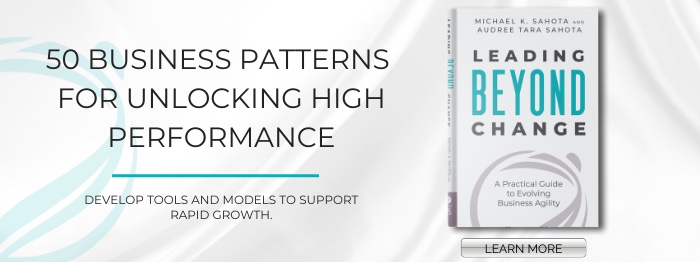The single biggest challenge facing leaders today is not fully understanding the negative consequences of traditional leadership. This is closely followed by the challenge of not knowing what to replace it with. In this post, we address both of these challenges so that leaders can move to higher performance patterns of leadership.
What Is Traditional Leadership?
In an organization based on traditional leadership, the people at the top have the power. They’re the smartest and most knowledgeable, and they use that power to run the organization. They tell people what to do, set up strategic plans, and direct the people working in the organization system.
Workers Have No Brains
When we peel back the layer on that structure, we can see that there’s an underlying assumption that workers have no brains. The fundamental structure of traditional management is based on the belief that people need to be told what to do for the organization to succeed. As a result of that, there’s a whole system of structures built.

It’s taught in Master’s of Business Administration programs that our job is to treat the people in the organization like parts of a machine, and to run the machine effectively. How do we optimize it? How do we reduce costs? How do we use our power to change what’s happening within that system to make it function better?
The overall paradigm is that there’s a separate thing called “the organization.” And we, with our power, wisdom, and intelligence, will know what to do to change what’s happening within that system to make it function better.

The Problem With Traditional Leadership
Traditional leadership leads to low levels of employee engagement that severely limit the productivity of an organization. It discourages people who are independent, resourceful, and show initiative. Instead, it produces workers who are unmotivated and avoid responsibility. Such organizations have difficulty attracting/retaining talent and adapting to changing market needs.

What Is Evolutionary Leadership?
Evolutionary Leadership is the choice to evolve yourself and develop the capabilities needed to evolve an organization. Evolutionary Leadership is a very different way of functioning. It’s about an integrated, holistic view of our organization system, where we are part of the system.
The System Includes You
From this understanding, if we want the system to evolve and grow into something more performant, we’re part of that system and we need to evolve and grow as well.
When we step into that role, we say, “Wait a second, I am part of a complex system. I can’t change anyone else, but I can change myself.” It starts to put some of the focus on the inner world: “How am I showing up, how is my behavior, how are my actions, and how are my choices creating the low-performance outcomes that we see around us?”

Creating a Shift
Once we have that shift, suddenly we approach things very differently: “This is a complex system. How do I nudge this system forward to start moving toward a healthier state of functioning? How do I take actions that will unlock people so they’re passionate and motivated? And most importantly, how do I stop disempowering and disengaging people?”
A Step Beyond Other Leadership Models
Other models like servant leadership and transformational leadership are steps in the right direction, but Evolutionary Leadership takes it a step beyond. We’re seeing ourselves as part of that larger organizational system and understanding our role in creating change.
Traditional Leadership vs Evolutionary Leadership

Modeling
A traditional leader might use terms like “walk the talk,” “lead by example,” and so on, but that doesn’t play much of a role in day-to-day activities. In a traditional leadership model, the general thought going through the leader’s head is, “I’m good, everybody else is the problem.” With an Evolutionary Leadership model, the thought going through the leader’s head is, “I can’t ask anyone to do anything I’m not doing myself.”
If I’m not seeing a desired behavior in my team, my first question is, am I modeling that behavior? Maybe there’s some growth to do on my part. I have to actually model the change I want to see. It’s not everyone else around me that’s the problem, I’m the problem. I’m setting the tone for the whole organization. I need to change first in order to get my people to change. This is the primary template for creating rapid change within the organization.
Organizational Focus
Where are we focused? In a traditional management model, people and the organization are something to be manipulated. It’s an external structure and I’m like a mechanic changing what’s actually happening within the organization. I need to manage the people, set objectives, and do something in that system to make it work.

When I come to an Evolutionary Leadership mindset, I understand that I’m part of the system. If the system isn’t functioning the way I’d like it to be, how do I elevate the system? How do I help the people? How do I create an environment where people want to show up?
In a traditional mindset, we’d say “How do I fix the employee engagement problem?” In an Evolutionary Leadership mindset, we say, “How are my choices and decisions? How do I create a more fertile environment where people show up with more passion, engagement, and excitement to create amazing products for our customers?” People are actually perfect: they just reflect back the system we’ve created for them as a leadership team.
Concluding Thoughts
Evolutionary Leadership is not for everyone. It’s only for those that want to create high levels of success and performance. Traditional leadership is the conventional, safe, accepted choice to keep creating the same types of status quo outcomes that have existed within most organizational systems for decades.
Every Leader Is Somewhere on The Spectrum
Every leader is somewhere on the spectrum from traditional to Evolutionary Leadership. It’s a journey, and the first step any of us can take is to understand where we are on the journey and realize that we all have places to grow and evolve to become even better leaders. The real question is, would we choose for ourselves? And through that, what do we choose for our organizations?



